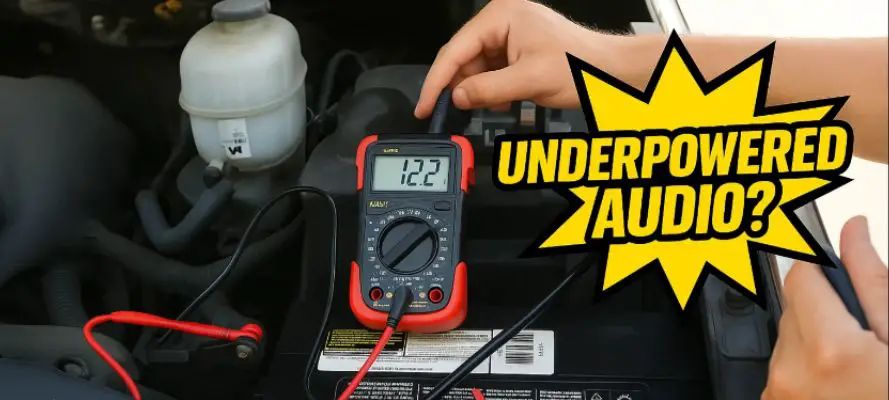If your car audio system features premium gear but still sounds weak or inconsistent, there's a good chance it's underpowered. I’ve seen this happen often distortion, amp shut-offs, or flat bass almost always come down to electrical issues, not equipment quality.
Power isn’t just about amp wattage it’s about voltage stability, current flow, and whether your car’s electrical system can handle high-demand components. Below are five key signs your system is underpowered and how I’ve helped others fix them fast.
In This Article
1. Dim Headlights When Bass Hits
One of the clearest signs that a car audio system is underpowered is when the headlights dim during bass-heavy tracks. This occurs because subwoofers and amplifiers draw significant current when reproducing low frequencies. If the vehicle’s alternator or battery can’t supply enough power, voltage drops become visible starting with the lights.
This is a classic indicator of voltage instability and often signals that the current electrical system isn’t built to support the audio setup’s demands.
What I Recommend:
In setups like this, I typically advise adding a second battery to support peak current draw. If the system is drawing power beyond what the stock alternator can provide, upgrading to a high-output alternator may also be necessary.
Not sure where to begin? I've outlined the best alternator options in my full guide: 7 Best High-Output Alternators for Car Audio
2. Weak or Clipping Bass at High Volume
If turning up the volume leads to distorted or clipped bass instead of a clean, powerful hit, the issue may stem from voltage instability. Amplifiers require consistent voltage to deliver clean output. When that voltage dips below the amp’s operational range often during demanding bass notes, the signal becomes distorted, and sound quality suffers.
Clipping doesn’t always result from gain misadjustment. In many of the systems I’ve tuned, the root cause was insufficient electrical support, the amplifier simply wasn’t getting the power it needed to operate properly.
What I Recommend:
Improve your system’s power delivery. This could involve installing a secondary battery, upgrading to thicker power wire, or checking if your main battery has adequate reserve capacity. For more insights, explore my full breakdown here: Do You Really Need a Second Battery for Car Audio? And if your answer is "yes," you might find the perfect second battery fit for your system from my lists here: caraudiohunt.com/best-secondary-battery-for-car-audio/
3. Amplifier Shutting Down or Going into Protect Mode
When an amplifier suddenly shuts off or enters protect mode, it's a built-in safety mechanism designed to prevent internal damage. In most cases, this is triggered by electrical instability, low voltage, poor grounding, or overheating caused by an underpowered system.
I’ve seen amps go into protect mode not because of faulty equipment, but because they were operating under electrical stress for too long. If it happens repeatedly, it's a clear sign the system isn't getting the power it needs.
What I Recommend:
Consider adding a secondary battery or car audio capacitor to buffer voltage during demand spikes. Also verify that your ground and power wiring is appropriately sized and properly installed.
4. Voltage Drops on Meters or Monitors
If you’re using a voltmeter or digital monitor to track system performance, voltage readings can quickly reveal power issues. A healthy system should maintain over 13V with the engine running and no less than 12V when off. Repeated dips below these thresholds signal that your battery or alternator is struggling to meet your system’s power demands.
Consistent voltage drops are one of the most reliable, measurable signs that a car audio system is underpowered especially under load.
What I Recommend:
I suggest installing a digital voltmeter if you don’t already have one, it’s a low-cost tool that offers real-time insight. If you’re consistently seeing unsafe dips, it’s time to consider power upgrades. A properly sized capacitor may help stabilize fluctuations. Learn what are the top-notch capacitors for voltage drop.
5. System Plays Fine When Engine’s On, But Struggles When Off
If your car audio system performs well with the engine running but loses strength or shuts down when the engine is off, it’s a strong indication that the setup is relying solely on a cranking battery. These batteries are designed for short bursts of high current, not sustained power delivery which makes them poorly suited for extended engine-off listening.
I’ve seen this issue occur often in systems without a secondary battery or proper electrical isolation, where the starter battery drains quickly and audio performance drops off.
What I Recommend:
For reliable performance with the engine off, install a deep-cycle or lithium battery dedicated to your audio system. I also recommend adding a battery isolator to prevent your starter battery from being depleted during extended play sessions. This setup ensures better system stability and protects your vehicle’s starting power. To explore different battery isolator types for car audio check out this guide: caraudiohunt.com/types-of-battery-isolators-for-car
Ready to Fix Your Power Problem?
If your car audio system is showing signs of being underpowered, don’t ignore it; power issues can limit performance and cause long-term damage. Whether you need a second battery, a better alternator, or a smarter setup, the right upgrade makes all the difference.
And if you're factoring in installation costs before making those upgrades, here’s a complete breakdown of how much a car audio installation costs so you can plan your budget wisely.
Explore my full guide library on car audio electrical systems and start building a setup that delivers clean, reliable power, no matter how loud you play.

